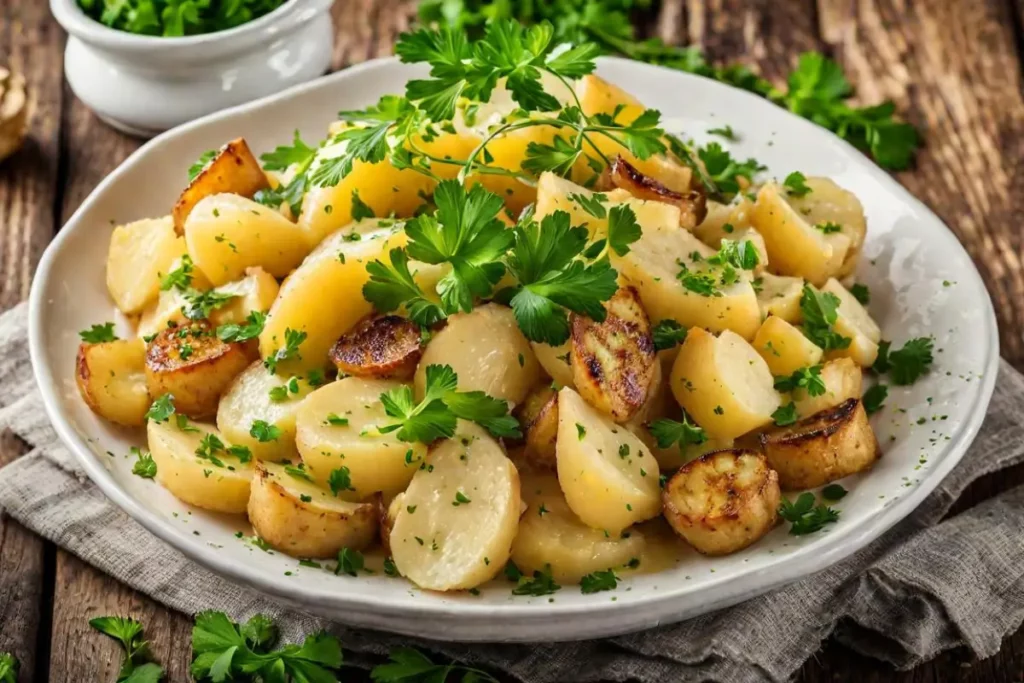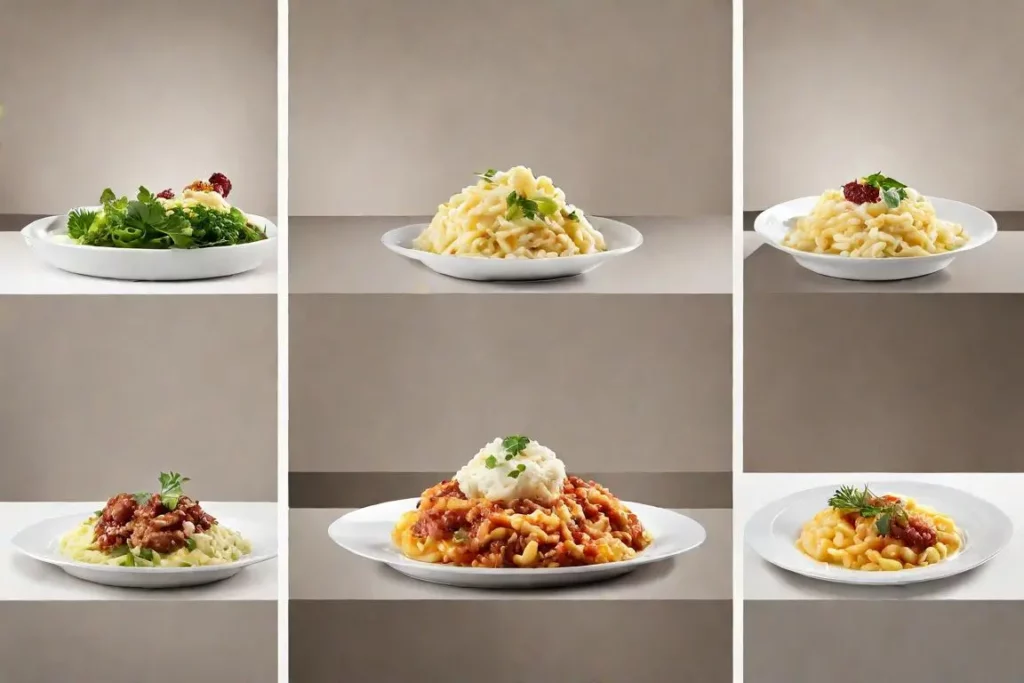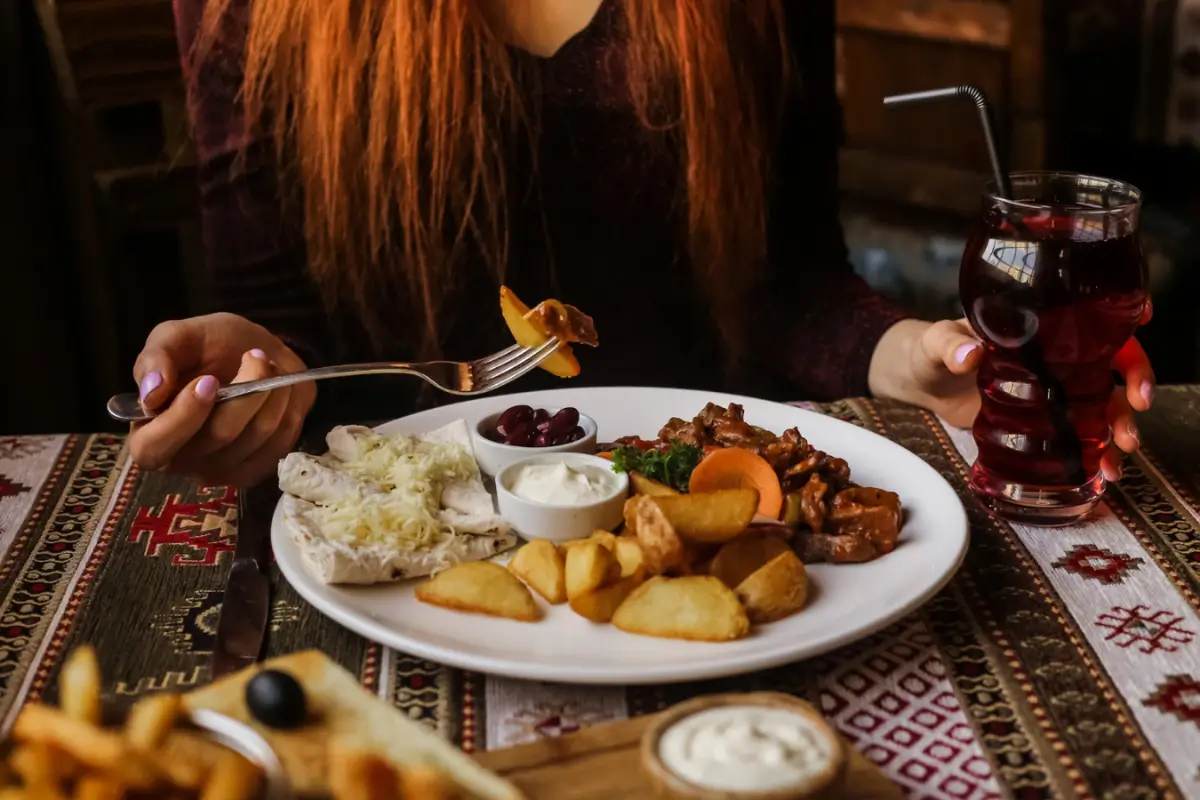Welcome to a mouth-watering journey through the heart of German cuisine, a realm where hearty flavors and robust side dishes reign supreme. In this exploration, we’re diving deep into the soul of German culinary traditions, particularly focusing on the unsung heroes of the dining table: side dishes. These are not just mere accompaniments; they’re a testament to Germany’s rich culinary heritage, each dish weaving a story of regional flavors and historical influences.
A Brief History of German Cuisine
German cuisine, a tapestry of diverse regional culinary arts, has evolved through centuries of social and political changes. Interestingly, it’s not just about sausages and beer; there’s so much more to this hearty European cuisine. From the potato-rich dishes in the North to the noodle and dumpling delights in the South, German food is a vibrant mosaic of flavors.
The Role of Side Dishes in German Meals
In the realm of German dining, side dishes are not just afterthoughts; they’re central to the meal, offering a delightful contrast and complement to the main courses. Whether it’s the tangy Sauerkraut or the comforting Kartoffelsalat (potato salad), these sides are essential in creating a well-rounded German feast. They bring balance, texture, and flavor, turning every meal into a celebration of taste.
As we embark on this culinary adventure, remember, German side dishes are more than just food on a plate; they’re a journey through history, culture, and regional diversity. So, let’s roll up our sleeves and delve into the delicious world of German side dishes, where every bite tells a story.
Savoring Traditional German Side Dishes

In the heart of German cuisine lies a treasure trove of side dishes, each brimming with flavors that have stood the test of time. Let’s embark on a culinary expedition, exploring some of the most beloved traditional German side dishes that have become staples at dining tables across the country.
Potato-Based Delights: Kartoffelsalat and Bratkartoffeln
First up, let’s talk potatoes, a staple in German kitchens. The humble potato transforms into culinary masterpieces, and two dishes stand out: Kartoffelsalat and Bratkartoffeln.
- Kartoffelsalat (Potato Salad): This isn’t your average potato salad. In Germany, Kartoffelsalat varies from region to region. In the South, it’s typically dressed with a vinegar-based sauce, while in the North, a creamy, mayo-based dressing is more common. Each bite of this salad is a delightful mix of tangy and creamy, with potatoes perfectly absorbing the flavors.
- Bratkartoffeln (Fried Potatoes): Imagine thinly sliced potatoes fried to golden perfection, often with onions, bacon, and a hint of seasoning. Bratkartoffeln is a versatile dish, perfect as a side for meat dishes or even as a hearty breakfast component. It’s the simplicity and the rustic charm of this dish that makes it a beloved choice in German households.
Cabbage Creations: Sauerkraut and Rotkohl
Next, we delve into the world of German cabbage dishes, renowned for their health benefits and distinctive flavors.
- Sauerkraut: Fermented cabbage might sound simple, but Sauerkraut is a German classic with a tangy and slightly sour taste that complements a variety of dishes, especially pork. It’s not just food; it’s a cultural icon, rich in history and tradition.
- Rotkohl (Red Cabbage): This sweet and sour dish, often spiced with cloves, apple slices, and red wine, is a festive addition to any meal. Rotkohl is more than just a side; it’s a colorful celebration on your plate, offering a perfect balance to hearty meats.
Unique Dumplings: Knödel and Spätzle
Finally, we can’t talk about German side dishes without mentioning the beloved dumplings, Knödel and Spätzle.
- Knödel (Dumplings): These come in various forms, from potato to bread dumplings. They’re the perfect vehicle for soaking up sauces and gravies, making them a favorite alongside dishes like Sauerbraten (marinated roast).
- Spätzle (Egg Noodles): These soft egg noodles are a specialty in southern Germany. Often served with butter, cheese, or gravy, Spätzle offers a delightful texture and is a comforting addition to any meal.
Regional Specialties and Contemporary Variations

German cuisine, much like its culture, is beautifully diverse. This diversity shines through in the regional variations of its side dishes. In Part 3, we’re exploring how these traditional dishes vary across different parts of Germany and how modern influences have introduced contemporary twists.
Northern vs Southern German Sides
The culinary divide between Northern and Southern Germany is fascinating. The North, with its cooler climate, leans towards heartier, potato-based sides, while the South, with its diverse agricultural landscape, showcases a variety of noodle and dumpling dishes.
- Northern Delicacies: In the North, dishes like Kartoffelsalat are made with a creamy, mayonnaise-based dressing, reflecting the region’s love for rich, comforting flavors. Bratkartoffeln here might include a smoky note, often accompanied by herring or other seafood.
- Southern Savories: Moving to the South, you’ll find a preference for lighter, vinegar-based dressings in their Kartoffelsalat. Dumplings like Spätzle and Knödel are more prevalent, often served with meaty stews and roasts, showcasing the region’s affinity for combining textures.
Fusion and Modern Interpretations
The beauty of German side dishes lies in their adaptability. Modern German cuisine has embraced global influences, leading to innovative twists on classic recipes.
- Fusion Flavors: Imagine Bratkartoffeln with a dash of curry or Spätzle tossed in a pesto sauce. These fusion dishes blend traditional German flavors with international ingredients, creating exciting new tastes.
- Contemporary Twists: Health-conscious adaptations are also on the rise. For instance, Sauerkraut is being reinvented in salads and as a topping for modern dishes like veggie burgers, while Rotkohl is finding its way into gourmet sandwiches and wraps.
Explore how German culture and lifestyle influence its culinary evolution.
Cooking German Sides in Your Kitchen
Bringing the essence of German cuisine into your home kitchen is easier than you might think. In Part 4, we’re focusing on how you can recreate these delectable German side dishes, infusing your meals with a taste of Germany. Whether you’re a seasoned cook or a beginner, these tips and recipes will guide you through the process.
Essential Ingredients and Techniques
The key to authentic German side dishes lies in using the right ingredients and mastering a few basic techniques.
- Quality Ingredients: Stock your pantry with staples like potatoes, cabbage, flour, and eggs. Freshness is crucial for dishes like Kartoffelsalat and Rotkohl, so choose your produce carefully.
- Mastering Techniques: Perfecting the art of potato boiling for Kartoffelsalat, learning to ferment cabbage for Sauerkraut, or getting the consistency right for Spätzle dough are essential skills. Don’t be afraid to experiment and adjust recipes to your taste.
Easy-to-Follow German Side Dish Recipes
Now, let’s dive into some easy recipes that you can try at home.
- Kartoffelsalat (Potato Salad): Start by boiling potatoes until they’re just right – tender but not falling apart. Mix with a dressing of your choice (mayo-based for a Northern style or vinegar-based for a Southern style), add some finely chopped onions, and season to taste.
- Bratkartoffeln (Fried Potatoes): Slice your potatoes thinly, fry them in a pan with onions and bacon until they’re crispy and golden, and season with salt, pepper, and a hint of paprika.
- Sauerkraut: This fermented cabbage dish can be made at home by combining shredded cabbage with salt and letting it ferment over several weeks. It’s a test of patience but well worth the wait.
- Spätzle: Mix a simple dough of eggs, flour, and water, then push it through a Spätzle maker or a colander into boiling water. Once they float to the surface, they’re ready to be tossed in butter or served with your favorite gravy.
Answering Common Questions About German Side Dishes
As we delve deeper into the world of German cuisine, it’s natural to have questions about these flavorful side dishes. In Part 5, we address some of the most common queries, drawing from the ‘people also ask’ section, to enhance your understanding and appreciation of German side dishes.
Popular Queries from ‘People Also Ask’
Kartoffelsalat (Potato Salad), Sauerkraut (Fermented Cabbage), Bratkartoffeln (Fried Potatoes), Rotkohl (Red Cabbage), and Spätzle (Egg Noodles) are among the most beloved side dishes in Germany. Each offers a unique taste and complements various main courses.
Northern Germany favors hearty, potato-based sides like Bratkartoffeln, often with a creamy dressing. In contrast, Southern Germany is known for its dumplings like Spätzle and vinegar-based Kartoffelsalat. Regional variations reflect the local climate, culture, and agricultural produce.
Absolutely! Many German side dishes are naturally vegetarian, like Spätzle and Rotkohl. For a vegan version, you can modify recipes by substituting animal products with plant-based alternatives. For instance, use vegan mayo in Kartoffelsalat or omit bacon in Bratkartoffeln.
Yes, dishes like Bratkartoffeln and simple cabbage salads are quick to prepare. They require minimal ingredients and can be a great way to introduce German flavors into your everyday meals.
Use fresh, quality ingredients and stick to traditional recipes for the best results. Don’t shy away from experimenting with flavors and textures to suit your palate. Remember, cooking is an art, and German cuisine allows plenty of room for creativity.
Embracing the Diversity of German Side Dishes
As we conclude our culinary journey through the world of German side dishes, it’s clear that these dishes are much more than mere accompaniments. They are a vibrant expression of Germany’s rich culinary heritage, reflecting the diversity of its regions and the creativity of its people.
Learn more about the rich cultural heritage and traditions of Germany.
The Joy of Discovering New Flavors
German side dishes offer a delightful array of flavors and textures, from the creamy and comforting Kartoffelsalat to the tangy and crisp Sauerkraut. Each dish tells a story of tradition, regional influences, and the evolving tastes of a nation. Whether you’re a fan of hearty potatoes, nourishing cabbage, or delicate dumplings, there’s something in German cuisine that will tantalize your taste buds.
The beauty of these dishes lies in their versatility. They can be adapted to suit various dietary preferences and can be dressed up or down to suit any occasion. Whether it’s a family dinner, a festive celebration, or a simple weekday meal, German side dishes can elevate your dining experience.
As we wrap up, remember that the world of German side dishes is vast and varied. There’s always something new to discover, a new recipe to try, and a new flavor to savor. So, don’t hesitate to explore and experiment with these delightful dishes in your own kitchen.
Kartoffelsalat (German Potato Salad)
Ingredients:
- 1.5 pounds of waxy potatoes (e.g., Yukon Gold)
- 1 small onion, finely chopped
- 4 tablespoons white vinegar
- 3 tablespoons vegetable or chicken stock
- 1 teaspoon Dijon mustard
- 4 tablespoons olive oil
- Salt and pepper, to taste
- 2 tablespoons fresh parsley, chopped
- Optional: 3-4 slices of bacon, cooked and crumbled
Directions:
- Boil the Potatoes: Wash the potatoes and boil them in salted water until they are just tender. Drain and let them cool slightly. Then, peel and slice them into thin rounds.
- Prepare the Dressing: In a small bowl, whisk together the vinegar, mustard, and stock. Slowly add the olive oil, whisking continuously to create an emulsion. Season with salt and pepper.
- Combine and Marinate: Place the sliced potatoes and finely chopped onion in a large bowl. Pour the dressing over the potatoes and gently mix to ensure all slices are coated. Let the salad sit for at least an hour to absorb the flavors, stirring occasionally.
- Garnish and Serve: Just before serving, sprinkle with fresh parsley and, if desired, the crumbled bacon. Adjust seasoning if necessary.
Bratkartoffeln (German Fried Potatoes)
Ingredients:
- 4 large potatoes, peeled
- 1 large onion, sliced
- 4-5 slices of bacon (optional)
- Salt and pepper, to taste
- 2 tablespoons vegetable oil or lard
- Fresh parsley, chopped (for garnish)
Directions:
- Pre-Cook the Potatoes: Boil the peeled potatoes until they are half-cooked. Let them cool, then slice them into thin rounds.
- Fry the Bacon: If using bacon, fry it in a large pan until crisp. Remove the bacon and set aside, leaving the fat in the pan.
- Cook the Potatoes and Onions: Heat the oil or lard in the same pan. Add the sliced potatoes and cook until they start to turn golden brown. Add the sliced onions and continue to fry until the potatoes are crispy and the onions are caramelized. Season with salt and pepper.
- Serve: Crumble the cooked bacon over the potatoes (if used), garnish with fresh parsley, and serve hot.
These recipes offer a taste of traditional German cuisine and are perfect as side dishes for various main courses. Enjoy your cooking and the delicious flavors of Germany!
Chef Advice
Remember, the key to authentic German side dishes lies in the quality of ingredients and patience in preparation. Don’t rush the cooking process; let the flavors develop fully to bring out the true essence of German cuisine.


3 thoughts on “German Side Dishes: Traditional Recipes and Cooking Tips”